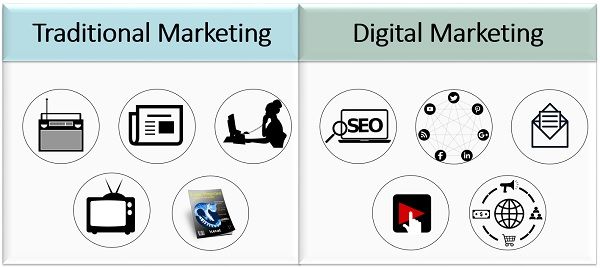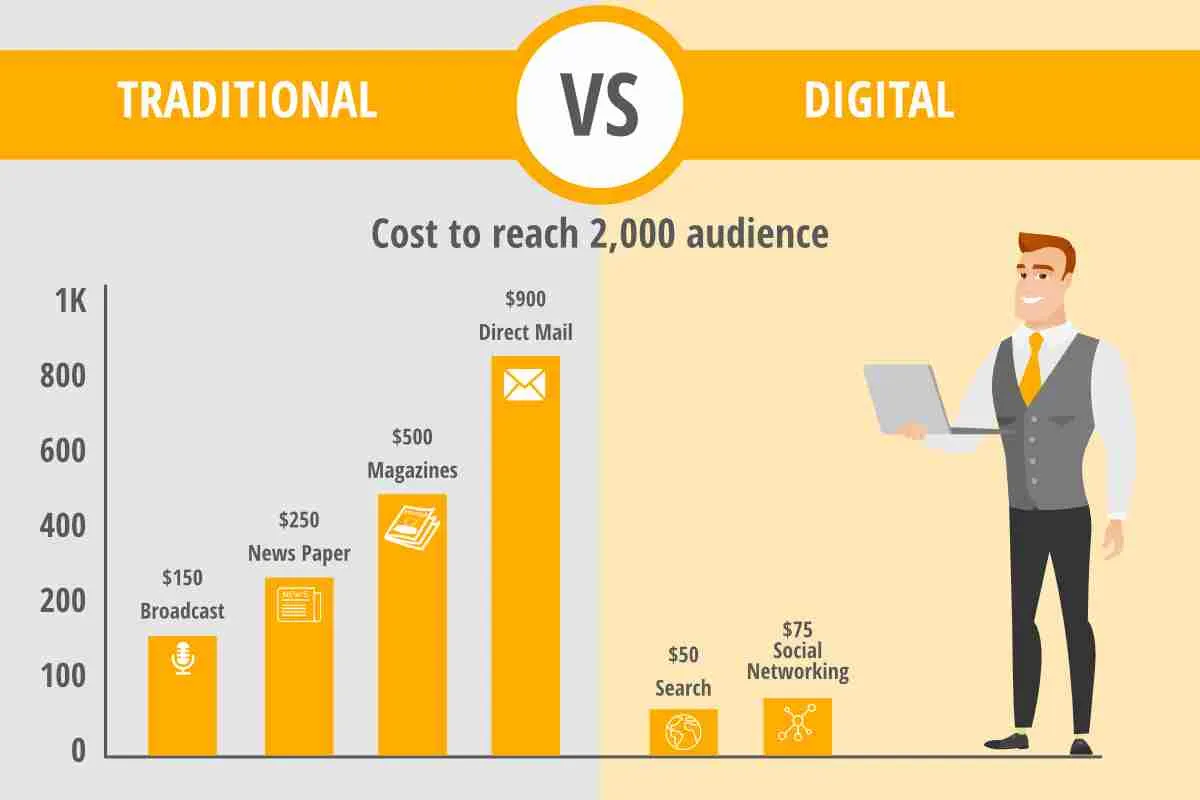For business owners and marketers, every decision about where to spend your hard-earned money is a big one. When you look at the debate between traditional marketing vs digital marketing, it’s not really about old versus new but also about finding the strategy that delivers real, measurable results for your business.
This comparison is designed to help you with that choice. By breaking down the effectiveness, cost, and scalability of each approach, you’ll be in a better position to invest smarter and see your business grow faster.
Key Takeaway:
- Traditional marketing builds credibility but is less flexible.
- Digital marketing is cost-effective and data-driven.
- A hybrid approach maximizes impact and reach.
Traditional Marketing vs Digital Marketing
Success in contemporary marketing demands fluency in both conventional and digital channels. Traditional marketing relies on offline channels, including TV, radio, and postal mail, to broadcast messages broadly without direct interaction. Digital marketing, however, uses online platforms for targeted, two-way interactions that are personalized and performance-tracked.
Understanding the core difference between digital marketing and traditional marketing is the key to unlocking a superior strategy. You’re going to look at the facts to see which strategy helps you get more customers, so you can spend every dollar on what truly matters.
1. Methods
 Marketing methods | Source: keydifferences.com
Marketing methods | Source: keydifferences.com
Traditional marketing uses broad, high-investment channels like TV, outdoor ads, and direct mail to build brand awareness. According to MarketingSherpa, these mediums are seen as more trustworthy by certain groups, especially older adults and those less engaged with digital media. This approach suits established brands, local businesses, and industries where trust and presence matter, such as finance and luxury goods.
In contrast, digital marketing targets specific audiences through social media, search, and email with measurable, cost-effective tactics. It’s ideal for performance-focused marketers in tech, e-commerce, and brands reaching younger or niche demographics.
2. Cost
 Marketing cost comparison | Source: assetdigitalcom.com
Marketing cost comparison | Source: assetdigitalcom.com
Established brands with larger budgets often utilize traditional marketing, such as TV, billboards, and print, to reach broad or older audiences where mass visibility and brand recognition are priorities, despite their reliance on high-cost channels.
In contrast, digital marketing uses targeted, performance-based strategies like real-time bidding and scalable campaigns, better suited for businesses focused on measurable results and flexibility.
Also Read: 8 Proven Digital Marketing Strategies for Startups to Boost Growth
3. Flexibility
A core aspect of traditional marketing vs digital marketing key differences is flexibility and adaptability. Traditional marketing relies on fixed messaging and set timelines, making it hard to adjust once campaigns launch. It’s more suited to long-term brand-building.
Digital marketing, on the other hand, enables real-time changes to ads, budgets, and targeting based on performance data. This flexibility allows for continuous improvement, making it ideal for agile, ROI-focused industries like e-commerce and tech.
4. Measurability
Traditional marketing channels like print ads or direct mail offer limited tracking and make it hard to measure direct impact. They’re better suited for established brands aiming for broad visibility.
In contrast, digital marketing provides detailed analytics on user behavior, like clicks, location, and conversions, allowing for precise performance tracking and optimization. This makes it ideal for performance-driven sectors that depend on measurable ROI and targeted strategies.
5. Reach
Traditional marketing uses broad-reach channels to deliver messages to wide audiences, making it effective for established brands focused on mass awareness. In contrast, digital marketing leverages data to target specific audience segments based on demographics, interests, and behavior, making it ideal for businesses that prioritize measurable engagement and conversions.
Also Read: Digital Marketing Strategies for Eco-Conscious Companies
Advantages and Limitations: Traditional Marketing vs Digital Marketing
 Traditional marketing vs digital marketing | Source: htmedia.in
Traditional marketing vs digital marketing | Source: htmedia.in
a. Traditional Marketing
Advantages:
- Printed materials: Flyers, brochures, and posters are tangible, providing a physical reminder that people can hold onto and keep.
- Community focus: Ideal for reaching local or regional audiences.
- Trust factor: Feels more reliable than online ads.
Drawbacks:
- Expensive: Running ads in print or TV usually requires a big budget.
- Hard to adjust: Once launched, campaigns can’t be easily changed.
- Tough to track: Measuring exact results is often unclear or limited.
b. Digital Marketing
Advantages:
- Borderless Impact: Digital marketing erases geographical limits.
- Maximized Budgets: Reduces waste compared to traditional media by focusing spending where it performs best.
- Transparent Performance: Tracks clicks, views, and conversions in detailed, easy-to-understand dashboards.
- Live Optimization: Allows quick changes to improve results and scale effective tactics.
Drawbacks:
- Technical Barriers: Demands specialized digital skills that go beyond basic marketing knowledge.
- Fierce Competition: Compels brands to compete for visibility in highly saturated digital environments.
- Resource Drain: Overwhelms lean teams with constant platform updates and campaign demands.
- Ad Blindness: Battles increasing consumer use of ad blockers and banner blindness.
- Trust Deficit: Struggles with perceived legitimacy when compared to established traditional channels.
Also Read: 10 Creative Digital Marketing Tactics to Boost Engagement
When to Merge Traditional and Digital Marketing
 Integrated marketing strategy | Source: adelabiancahan.blogspot.com
Integrated marketing strategy | Source: adelabiancahan.blogspot.com
The debate over “traditional marketing vs digital marketing which is better” is outdated. The real key to success is moving beyond a simple comparison and combining both strategies into an integrated marketing approach. By doing so, brands can create a cohesive message, boost reach, and boost brand growth. Use this when you need to:
- Launch a new product (TV ads create buzz + digital retargets interested viewers).
- Dominate local markets (billboards drive recognition + geo-targeted mobile ads convert).
- Build brand authority (radio interviews reach a broad audience + a podcast series provides in-depth expertise).
Also Read: 10 Credible Omnichannel Trends to Dominate the Digital Market
Traditional Marketing vs Digital Marketing: Unifying Your Message With Design
When comparing traditional marketing vs digital marketing, the key takeaway is that both work best when integrated. Digital offers precision and measurable results, while traditional builds trust and local presence.
Equally important is visual identity, as elements like typography help maintain consistency and make your message more recognizable across all platforms. That’s where a well-crafted display font collection can make a difference. It adds clarity and cohesion to brochures, billboards, social posts, and ads.
At Creatype Studio, you’ll find professional, web- and print-ready fonts designed for versatility and impact, helping your message not only stand out but also resonate with your audience.




